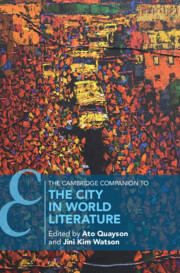Book contents
- The Cambridge Companion to the City in World Literature
- The Cambridge Companion to the City in World Literature
- Copyright page
- Contents
- Contributors
- Chronology of Political, Literary, and Cultural Events
- Chapter 1 Introduction
- Part I Critical Approaches
- Part II Spotlight Literary Cities
- Chapter 5 The Neighborhood and the Sweatshop
- Chapter 6 “The Whole World in Little”
- Chapter 7 Unworlding Paris
- Chapter 8 Sketching the City with Words
- Chapter 9 Romance and Liminal Space in the Twentieth-Century Cairo Novel
- Chapter 10 Bombay/Mumbai and its Multilingual Literary Pathways to the World
- Chapter 11 At Home in the World
- Chapter 12 Imagining the Migrant in Twenty-First Century Johannesburg
- Chapter 13 Russia
- Chapter 14 “Cityful Passing Away”
- Chapter 15 From Altepetl to Megacity
- Chapter 16 (In)Visible Beijing Within and Without World Literature
- Chapter 17 Worlding Lagos in the Long Twentieth Century
- Chapter 18 Haunted Vitality
- Select Bibliography
- Index
- Cambridge Companions To …
Chapter 12 - Imagining the Migrant in Twenty-First Century Johannesburg
from Part II - Spotlight Literary Cities
Published online by Cambridge University Press: 13 July 2023
- The Cambridge Companion to the City in World Literature
- The Cambridge Companion to the City in World Literature
- Copyright page
- Contents
- Contributors
- Chronology of Political, Literary, and Cultural Events
- Chapter 1 Introduction
- Part I Critical Approaches
- Part II Spotlight Literary Cities
- Chapter 5 The Neighborhood and the Sweatshop
- Chapter 6 “The Whole World in Little”
- Chapter 7 Unworlding Paris
- Chapter 8 Sketching the City with Words
- Chapter 9 Romance and Liminal Space in the Twentieth-Century Cairo Novel
- Chapter 10 Bombay/Mumbai and its Multilingual Literary Pathways to the World
- Chapter 11 At Home in the World
- Chapter 12 Imagining the Migrant in Twenty-First Century Johannesburg
- Chapter 13 Russia
- Chapter 14 “Cityful Passing Away”
- Chapter 15 From Altepetl to Megacity
- Chapter 16 (In)Visible Beijing Within and Without World Literature
- Chapter 17 Worlding Lagos in the Long Twentieth Century
- Chapter 18 Haunted Vitality
- Select Bibliography
- Index
- Cambridge Companions To …
Summary
The chapter engages 21stcentury Johannesburg through the motif of the migrant. Colonial and apartheid discourses of the city asserted worldliness by insisting on its Eurocentricism, but from its inception it has been physically and psychically shaped by African migrants. The chapter reads the migrant city across three lenses: indeterminacy, hostility and the speculative. The experimental turn in Johannesburg fictions of the 2000s, represented here by Phaswane Mpe and Ivan Vladislavic, imagine a transnational, if contested, city. However, by the 2010s, spatial and formal ambiguity yield to a realism that bears witness to the xenophobic attacks of 2008 and 2015. The writing of diasporic authors such as Novuyo Rose Tshuma and Sue Nyathi, prompts us to imagine Johannesburg from the perspective of the imperilled migrant, for whom the city is often unliveable. In turn, depictions of the city as threat have been complicated by the rise of speculative fiction in whichthe ‘alien’ migrant points towards configurations that are resolutely global. In Lauren Beukes’s and Masande Ntshanga’s work, Johannesburg is a nodal point for imagining affiliations that exceed the boundaries of the human, and the frontiers of the world itself.
- Type
- Chapter
- Information
- The Cambridge Companion to the City in World Literature , pp. 183 - 200Publisher: Cambridge University PressPrint publication year: 2023



